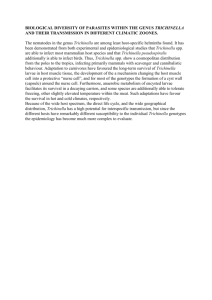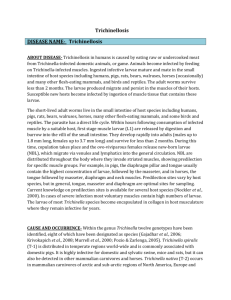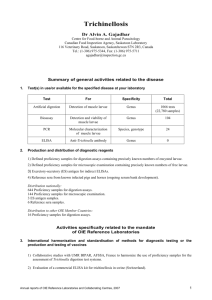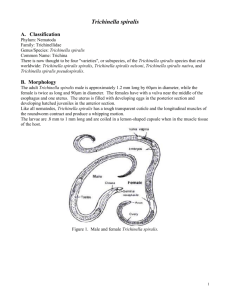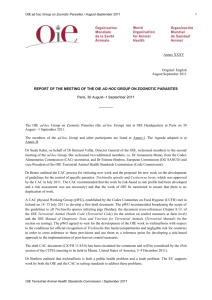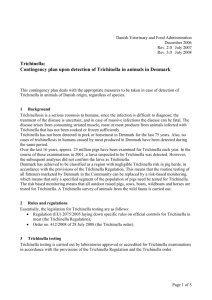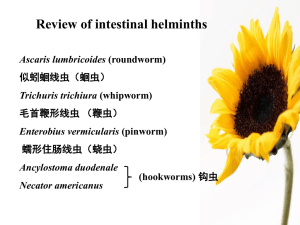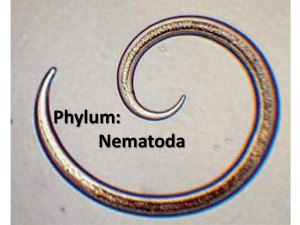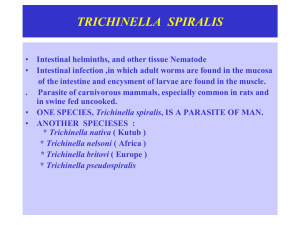Meat samples for proficiency tests
advertisement
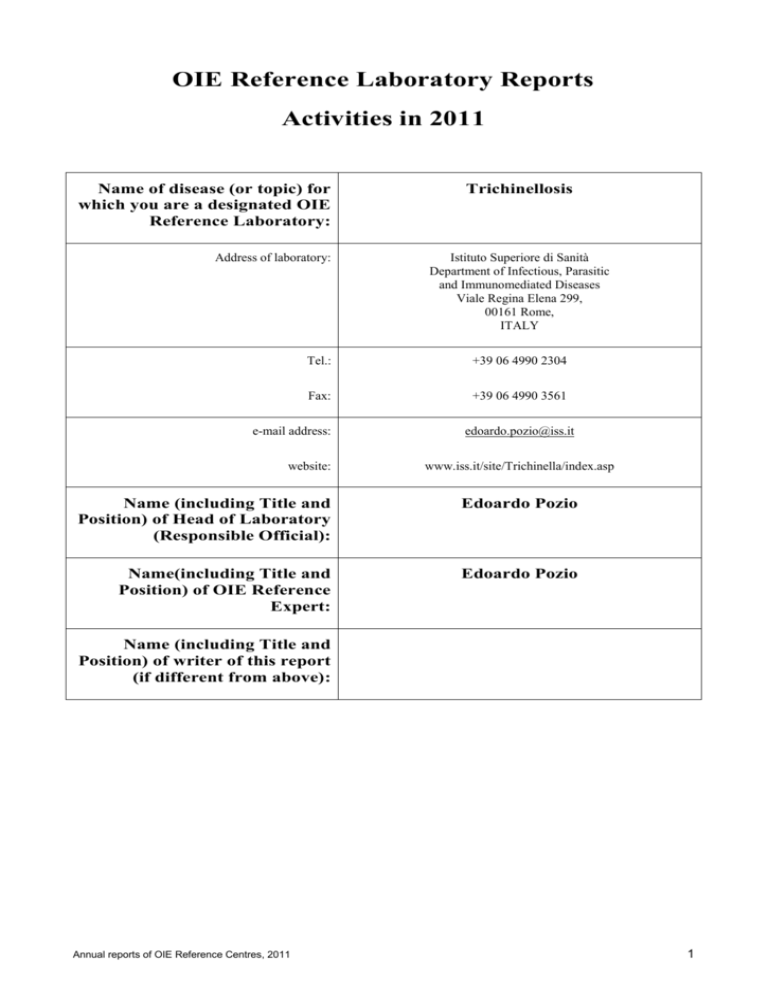
OIE Reference Laboratory Reports Activities in 2011 Name of disease (or topic) for which you are a designated OIE Reference Laboratory: Address of laboratory: Trichinellosis Istituto Superiore di Sanità Department of Infectious, Parasitic and Immunomediated Diseases Viale Regina Elena 299, 00161 Rome, ITALY Tel.: +39 06 4990 2304 Fax: +39 06 4990 3561 e-mail address: website: edoardo.pozio@iss.it www.iss.it/site/Trichinella/index.asp Name (including Title and Position) of Head of Laboratory (Responsible Official): Edoardo Pozio Name(including Title and Position) of OIE Reference Expert: Edoardo Pozio Name (including Title and Position) of writer of this report (if different from above): Annual reports of OIE Reference Centres, 2011 1 Trichinellosis Part I: Summary of general activities related to the disease The Istituto Superiore di Sanità (ISS) is the leading technical and scientific public body of the Italian National Health Service. Its activities include research, control, training and consultation in the interest of public health protection. Two sections of the Department of Infectious, Parasitic and Immunomediated Diseases, namely the Section of gastroenteric and tissue parasitic diseases and the Section of vector borne diseases and international health, are working in the field of parasites and parasitic diseases. The OIE reference laboratory of trichinellosis is appointed at the Section of gastroenteric and tissue parasitic diseases. 1. 2. Test(s) in use/or available for the specified disease/topic at your laboratory Test For Specificity ELISA Antibody pig ELISA Antibody human Western blot Antibody pig Western blot Antibody human PCR Parasite identification species Total 2,945 Production and distribution of diagnostic reagents Type of reagent Amount supplied nationally (including for own use) Amount supplied to other countries Control positive pig sera 2 mL 23 mL Antigens for 30,400 tests 2.4 mg 35.6 mg Reference larvae 6 9 Meat samples for proficiency tests 495 414 Part II: Activities specifically related to the mandate of OIE Reference Laboratories 3. International harmonisation and standardisation of methods for diagnostic testing or the production and testing of vaccines a) Establishment and maintenance of a network with other OIE Reference Laboratories designated for the same pathogen or disease and organisation of regular inter-laboratory proficiency testing to ensure comparability of results Two ring trials have been organised: - 2 to detect Trichinella larvae in meat samples. Twenty-eight labs from 26 countries of the European Union and 2 outside the EU (Serbia, Switzerland) participated. The scope was to evaluate the performance of national reference laboratories for Trichinella to detect the parasites in the meat samples for the maintenance of the accredited method or to validate the method. Ten samples (nine spiked with Trichinella larvae and one Annual reports of OIE Reference Centres, 2011 Trichinellosis negative) of 100 g each of pork and/or horse meat were sent to each lab. The outcome was quite good. In fact, only few labs failed to recognise as positive some of the samples with a low number of larvae. - To identify the species/genotype of Trichinella larvae. Then samples containing single or pool of larvae were sent to 12 EU labs and 2 labs outside the EU (Serbia, Switzerland). The outcome was quite good. In fact, only few labs failed to identify some larvae. An interlaboratory test evaluation has been organized to validate a commercial kit to detect Trichinella infection in meat samples by a latex agglutination test. The kit has been evaluated by five international labs with positive outcomes. 4. Preparation and supply of international reference standards for diagnostic tests or vaccines None. 5. Research and development of new procedures for diagnosis and control The aim of the study was to identify the most frequently Trichinella specific antigens recognized by pig sera on excretory/secretory antigens (ESA) by western blot (wb), in order to define an unequivocal pattern of positive sera. To this end, 210 pig sera were tested by wb using ESA: 1) 30 from experimentally Trichinella infected pigs; 2) 90 from naturally Trichinella infected pigs for which the worm burden was known; and 3) 90 ELISA crossreacting sera (CRS) from Trichinella non-infected pigs. All sera from naturally and experimentally infected pigs reacted with the three band pattern of 48–72 Kd (first band from 48 Kd to 55 Kd, second band from 59 Kd to 63 Kd and third band from 64 Kd to 72 Kd). No one of the 90 pig CRS recognised the three band pattern. 6. Collection, analysis and dissemination of epizootiological data relevant to international disease control Trichinella britovi focus of the Sardinia island, Italy Up to 2005, the Island of Sardinia (Italy) of the Mediterranean basin has been considered free of Trichinella sp. in domestic and wild animals and in humans. In 2005, two human outbreaks occurred for the consumption of pork from free ranging pigs infected by Trichinella britovi in the Orgosolo village. The epidemiological investigation revealed the presence of four infected pigs (0.6%), but no infection was detected in wild boars and foxes hunted in the island. A passive introduction of the parasite from the neighbouring island of Corsica (France) was suspected. In January 2011, a new human outbreak of trichinellosis occurred in the same village of Orgosolo for the consumption of pork from pigs free ranging in the same municipality. The epidemiological investigation revealed the presence of 8 T. britovi infected animals (2.8%). The free-ranging pigs originating from municipalities neighbouring Orgosolo tested always negative. The discovery of T. britovi in Corsica in 2004 and its circulation among free ranging pigs and wild animals up to the recent years seem to be related. Trichinella spp. infections in different host species of an endemic district of Serbia During the 2009–2010 period, muscle samples were collected from 167 wild animals: 94 wild boars (Sus scrofa), 57 red foxes (Vulpes vulpes), 13 golden jackals (Canis aureus), 3 wolves (Canis lupus) and 116,398 domestic pigs. Trichinella spp. infection was detected in 302 (0.26%) domestic pigs, in 11 (11.7%) wild boars, 7 (12.3%) red foxes, 7 (53.8%) golden jackal, and 3 (100%) wolves. Trichinella spiralis and Trichinella britovi were the only two species identified in the isolates as single or mixed infections. The results point out the circulating of Trichinella species by a domestic or a sylvatic cycle, the transmission between these two cycles, and the role of some host species as reservoirs of T. spiralis or T. britovi or of both species in Serbia. Trichinella pseudospiralis in wild boars (Sus scrofa) of the Czech Republic In the Czech Republic, 121,185 wild boars (Sus scrofa) were hunted in 2009 and 96,232 of them were tested for Trichinella by artificial digestion. In December 2010 and January 2011, Trichinella sp. larvae were detected in three wild boars hunted in the eastern part of the Czech Republic. The larvae were identified as Trichinella pseudospiralis. All T. pseudospiralis-positive wild boars had similar weight (around 35 kg) and were shot at the same baited site by the same hunter. A common origin of the infection in the three wild boars has been hypothesized. These findings support the tendency of a more frequent detection of the non-encapsulated species T. pseudospiralis in Europe, which probably is related to the increased number of tested wild boars and to the use Annual reports of OIE Reference Centres, 2011 3 Trichinellosis of the artificial digestion instead of the less sensible trichinoscopy to detect these zoonotic parasites in meat samples. Molecular identification of nematode larvae different from those of the Trichinella genus detected by muscle digestion From 2008 to 2011, 15 nematodes isolated by artificial digestion from muscle tissues of different animal species tested for Trichinella, have been analysed (about 1% of those analysed as Trichinella spp. in the same period). Eight of these isolates have been successfully identified at the species, genus or family level by using four molecular markers (12S mtDNA; COI; 18S rDNA; ITS1). Nematode larvae isolated from birds (Falco tinnunculus; Circus cyaneus) and a pig, were identified as Toxocara cati; larvae from Meles meles were identified as Toxocara canis; larvae from a domestic pig were identified as belonging to a free living nematode of the genus Panagrolaimus; larvae from a wild boar (Sus scrofa) were identified as belonging to the Metastrongylus genus; and larvae from a rough-legged buzzard (Buteo lagopus) were identified as belonging to the superfamily Filarioidea. The recovery of nematodes different from those of the genus Trichinella during routine meat inspection, seems to be not so unusual showing the need to inform technicians in charge for the analysis about the possibility of false positives, and the need for a molecular based identification system allowing a reliable and quick response. 7. Maintenance of a system of quality assurance, biosafety and biosecurity relevant to the pathogen and the disease concerned The Reference Laboratory for Trichinellosis has been accredited by the Italian accreditation body ACCREDIA according to UNI EN/ISO 17025:2005, since 2006, and the accreditation was confirmed for 2011–2012 following the audit carried out on 7–8 July, 2011. Laboratory animals infected with Trichinella strains are maintained in an animal house under biosefty measures. 8. Provision of consultant expertise to OIE or to OIE Member Countries The reference lab has answered specific queries of European Commission and Italian Government on the Chapter 8.13 Infection with Trichinella spp. 9. Provision of scientific and technical training to personnel from other OIE Member Countries Four persons from Estonia, Italy and Latvia have been trained on Molecular identification of Trichinella species and on Digestion methods to detect Trichinella larvae in meat samples. Establishing an OIE Reference laboratory for Trichinella at the Botswana national veterinary laboratory for the southern Africa development community. Unfortunately, after the agreement signature in 2010, nobody from Botswana answered the emails which were sent to them to organize their visit to Italy according to the project. Only at the end of 2011, Dr Mercy W. Kawonga [mkawonga@gov.bw] sent an answer, but no other actions occurred. 10. Provision of diagnostic testing facilities to other OIE Member Countries a) Trichinella larvae identification at the species level by a multiplex PCR 4 OIE Member Country No. of tests Argentina 10 Bulgaria 65 Croatia 20 Czech Rep 10 Estonia 240 France 5 Annual reports of OIE Reference Centres, 2011 Trichinellosis OIE Member Country No. of tests Germany 85 Iran 10 Ireland 10 Italy 100 Latvia 335 Lithuania 325 Norway 65 Poland 1250 Romania 250 Serbia 30 Spain 15 South Africa 5 Sweden 75 Zimbabwe 5 Total 2945 11. Organisation of international scientific meetings on behalf of OIE or other international bodies A two-day workshop was organised in Rome on May 2011, on: 1. presentation and discussion of the results of the proficiency tests among European laboratories on the digestion method to detect Trichinella larvae in pork and/or horse meat; 2. presentation and discussion of epidemiological data on Trichinella in humans and animals; 3. Organization of PT to detect Trichinella larvae. Seventy-five people from 30 European countries attended the meeting. The workshop was organised by the European Union Reference Laboratory for Parasites. The meeting Agenda, presentations and report can be downloaded from: www.iss.it/crlp/wops/index.php?lang=2&tipo=25&anno=2011. A tree-day meeting entitled ‘Expert Workshop on Quality Assurance in Trichinella Inspection and Testing Programs’ was organised in Rome on November 2011. The meeting was organized by this OIE lab and the International Commission of trichinellosis (ICT) and it was in part funded by OECD. Sixteen people from 11 countries of Europe, America, Asia and Australasia attended the meeting. The final document will be published on the web site of ICT. 13. Publication and dissemination of information relevant to the work of OIE (including list of scientific publications, internet publishing activities, presentations at international conferences) Presentations at international conferences and meetings Communications at the 13th International Conference on Trichinellosis, Changchun, China, 1-6 August, 2011: Pozio E, Bandino E, Murgia MC, Soddu M, Interisano M, Amati M, Marucci G, Gomez Morales MA. An updating on the Trichinella britovi focus of the Sardinia island, Italy. Gómez Morales MA, Amati M, Ludovisi A, Schimmel H, Ramirez Villaescusa A, Pozio E. Towards the first international pig reference serum with anti-Trichinella antibodies: isochronous studies on the reference swine serum candidates. Gómez Morales MA, Amati M, Ludovisi A, Zivojinovic M, Blaga R, Ribicich M, Pozio E. Is possible to define the pattern of Trichinella sp. infection for human and pig sera by western blot? Annual reports of OIE Reference Centres, 2011 5 Trichinellosis Ludovisi A, La Grange LJ, Gómez Morales MA, Amati M, Pozio E. Development of a serological test to detect the humoral immune response against Trichinella zimbabwensis in Nile crocodiles (Crocodylus niloticus). Pozio E. The opportunistic nature of Trichinella - exploitation of new geographies and habitats. Pozio E., Krivokapich S, Marucci G. Cross-breedings between Trichinella T12 and the other encapsulated Trichinella species suggest its reproductive isolation. Marucci G., Interisano M, La Rosa G, Pozio E. Molecular identification of nematode larvae different from those of the Trichinella genus detected by muscle digestion. Marucci G., Interisano M, Gomez Morales MA, Glawischnig W, Claes M, Kärssin A, Zakrisson G, Pozio E. Validation of a latex agglutination test for the detection of Trichinella infections in pigs. Zivojinovic M, Sofronic-Milosavljevic Lj, Cvetkovic J, Pozio E, Interisano M, Radojicic S,.Kulusic Z. Trichinella spp. infections in different host species of an endemic district of Serbia. Koudela B1, Harna J, Račka K, Pozio E. Trichinella pseudospiralis in wild boars (Sus scrofa) of the Czech Republic. Scientific publications in peer-reviewed journals Murrell KD, Pozio E. 2011. Worldwide occurrence and impact of human trichinellosis, 1986-2009. Emerg Infect Dis 17:2194-202. Reichard MV, Tiernan KE, Paras KL, Interisano M, Reiskind MH, Panciera RJ, Pozio E. 2011. Detection of Trichinella murrelli in coyotes (Canis latrans) from Oklahoma and North Texas. Vet Parasitol. 182:368-71. Romano F, Motta A, Melino M, Negro M, Gavotto G, Decasteli L, Careddu E, Bianchi C, Bianchi DM, Pozio E. 2011. Investigation on a focus of human trichinellosis revealed by an atypical clinical case: after wild-boar (Sus scrofa) pork consumption in northern Italy. Parasite 18:85-7. Alban L, Pozio E, Boes J, Boireau P, Boué F, Claes M, Cook AJ, Dorny P, Enemark HL, van der Giessen J, Hunt KR, Howell M, Kirjusina M, Nöckler K, Rossi P, Smith GC, Snow L, Taylor MA, Theodoropoulos G, Vallée I, Viera-Pinto MM, Zimmer IA. 2011. Towards a standardised surveillance for Trichinella in the European Union. Prev Vet Med 99:148-60. Merialdi G, Bardasi L, Fontana MC, Spaggiari B, Maioli G, Conedera G, Vio D, Londero M, Marucci G, Ludovisi A, Pozio E, Capelli G. 2011. First reports of Trichinella pseudospiralis in wild boars (Sus scrofa) of Italy. Vet Parasitol 178:370-3. _______________ 6 Annual reports of OIE Reference Centres, 2011
